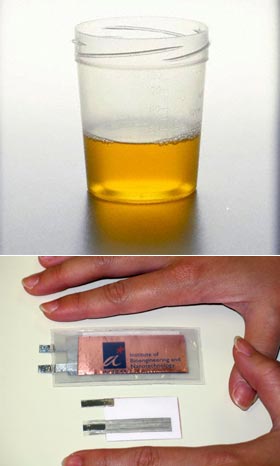尿液电池变废为宝(Urine Battery Turns Pee Into Power)(在线收听)
Before you next flush the toilet, consider this: Scientists in Singapore have developed battery powered by(用…推动的) urine(尿).
下次冲厕所之前,请不要忘记下面的介绍:新加坡的科学家发明了一种由尿液产生能量的电池。

Researchers at the Institute of Bioengineering and Nanotechnology created the credit card-size battery as a disposable power source for medical test kits(成套工具).
生物工程及纳米技术研究所的研究人员发明了一种信用卡大小的一次性电池,用于医学测试的能量源。
Scientists have been scrambling to create smaller, more efficient, and less expensive "biochips" to test for diseases such as diabetes(糖尿病). Until now, however, similarly small batteries to power the devices remained elusive(深奥,难懂).
科学家们费尽周折的发明了一种体积更小,效率更高,并且造价更低的生物芯片,用于像糖尿病一类疾病的检测。但迄今为止,类似的驱动这种芯片的电池仍旧未能推出。
Diagnostic test kits commonly analyze the chemical composition of a person's urine to detect a malady(疾病). Ki Bang Lee and his colleagues realized that the substance(物质) being tested—urine—could also power the test.
诊断测试工具一般通过分析病人尿液的化学成分来断定是否疾病存在。Ki Bang Lee 和他的同事意识到测试样本——尿液——同时可也作为测试工具的能源。
"In order to address this problem, we have designed a disposable battery on a chip, which is activated by biofluids such as urine," Lee wrote in an e-mail to National Geographic News.
Lee在给National Geographic 的E-mail 中叙述: “为了攻克这个难题,我们设计了一种芯片式的一次性电池,它可由生物体液,比如尿液,来驱动”.
The research team describes the battery in the current issue of the Journal of Micromechanics and
Microengineering.
Lee所在的研究小组将研究结果发表在最近一期的Micromechanics and Microengineering期刊上。
To make the battery, Lee and his colleagues soaked a piece of paper in a solution of copper chloride([化]氯化物) and sandwiched(做成三明治形) it between strips of magnesium and copper. This sandwich was then laminated between two sheets of transparent plastic.
Lee和他的同事将一张纸浸在氯化铜溶液中,再将浸后纸片夹在镁片和铜片之间,最后将制好的三层夹在两片透明的塑料板之间。
When a drop of (一滴)urine is added to the paper through a slit in the plastic, a chemical reaction takes place that produces electricity, Lee said.
Lee说,通过塑料板上的缝隙将尿液滴到纸片上,就会发生化学法应产生电能。
The prototype battery produced about 1.5 volts, the same as a standard AA battery, and runs for about 90 minutes. Researchers said the power, voltage, and lifetime of the battery can be improved by adjusting the geometry and materials used.
该电池原形产生电压1.5伏,相当于标准的AA电池一样,并可持续工作90分钟。研究人员透露,电池的能量,电压,和使用时间可以通过改变布片的几何位置和材料来调节。
Urine contains many ions (electrically charged atoms), which allows the electricity-producing chemical reaction to take place in the urine battery, said UC Berkeley's Kammen. Other bodily fluids, such as tears, blood, and semen, would work easily as well to activate the battery.
加州伯克利大学的Kammen表示:尿液富含很多离子(带电原子),这些离子是尿液发电的最根本原因。其他的体液,像眼泪,血液,和精液也可起到同样的作用。
While medical devices inspired(给…灵感) the urine battery, it can activate any electric device with low power consumption, according to Lee, the battery's co-inventor.
"For example, we can integrate a small cell phone and our battery on a plastic card. This can be activated by body fluids, such as saliva, during an emergency," he said.
电池的共同发明者Lee阁下说,医疗设备激发了该电池的发明,同时也会触动其他低能耗的电器设备的发展。“比如说,我们可以将微型移动电话和我们的电池整合到一张塑料卡片。 它就能够在危急时刻由体液(像唾液)驱动,发挥作用。”
According to Kammen the technology could even be applied to laptop computers, mp3 players, televisions, and cars. Body-fluid-powered batteries "can do all kinds of things. The issue is how they scale up" to produce more power, he said.
据Kammen所说,这项技术可应用于膝上电脑,mp3播放器,电视,和汽车。体液电池“可以无所不能,关键是它的规模大小”决定了是否可产生更强大的能量。
One approach is to simply build larger batteries. Another method is to link lots of little battery cells side by side, which is how the batteries in laptop computers work, Kammen explained.
Kammen解释:我们努力设计简单的大型的电池。现存的方法是将一系列微型电池链接起来,膝上电脑所采用的正是这种技术。
Kammen, who advocates government funding for alternative energy research, says the wide number of applications for cheap and efficient biofluid-powered batteries illustrates the value of research. "Investigation leads to innovation," he said.
Kammen拥护政府资助的可替代能源计划,他表示:大量的低投入高效率的体液电池已章显该计划的价值所在。“科研导致革新”。